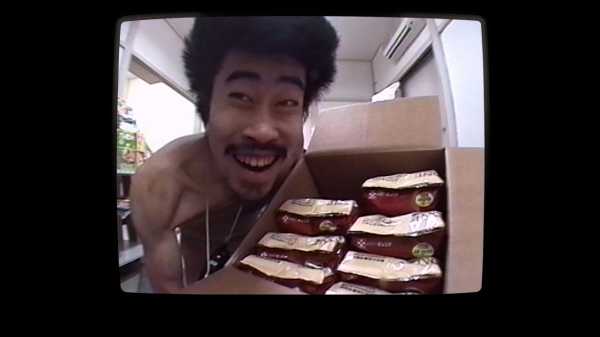
Save this storySave this storySave this storySave this story
Tomoaki Hamatsu became one of the world’s first reality-TV stars when, as an aspiring comedian in his early twenties, he spent fifteen months naked and alone, surviving on sheer luck. The challenge was among the most extreme to be featured on “Susunu! Denpa Shōnen,” a cheerfully sadistic series described as the “naughty boy” of the nineties Japanese television landscape. Hamatsu, whose strikingly long face earned him the nickname Nasubi (Japanese for “eggplant”), had gone in believing that he was auditioning for a chance to hitchhike across Africa. Instead, he was taken to a small Tokyo apartment, instructed to strip, and told that he would have to get by on the winnings from magazine sweepstakes—and that he wouldn’t be able to leave until he had garnered a million yen’s worth of prizes. Car tires, golf balls, a live lobster, and sundry other objects gradually poured in, along with just enough food to insure that the producers wouldn’t have to pull the plug on the experiment. (“If he hadn’t won rice, he would have died,” one observed, blithely, decades later.) Assured that little to none of this material would make it to air, Nasubi only discovered after his ordeal was over that the footage had formed the basis for a wildly successful “Denpa Shōnen” segment called “A Life in Prizes”—and that he had become a celebrity.
The Hulu documentary “The Contestant” revisits this strange early chapter of reality-television history with sensitivity and a willingness to suspend judgment. Its director, Clair Titley, treats her subjects with care, drawing meaningful confessions from both Nasubi and Toshio Tsuchiya, the man who masterminded the segment. Throughout, she balances the absurdity of the archival footage—on the show, Nasubi’s antics are scored to lively music and studio laughter, while a roving cartoon eggplant covers his genitals—with its grave physical and psychological effects. A quarter century on, Nasubi is still reckoning with the consequences of his confinement, which resulted in hair loss, body aches, and insomnia. His extreme loneliness and nutritional deficit may have contributed to his mental inability to escape. Somehow, when Nasubi finally reaches the finish line, Tsuchiya persuades him to sign up for what amounts to a second season.
One of the most startling facts about “A Life in Prizes” is that Nasubi was never locked in; he could theoretically have left the apartment at any time. From the beginning, Tsuchiya took advantage of his star’s gullibility and eagerness to please: Nasubi, a show-biz neophyte, never so much as signed a contract outlining his rights as a participant. (Nasubi has spoken elsewhere about how little he was paid for his time on the show, and there is no mention in the documentary of his receiving any proceeds from the toys made in his likeness or from the publication of the diary that he had been asked to write while on the show, which sold some eight hundred thousand copies.) The producer also forbade his crew from interacting with Nasubi, even as his distress at his isolation escalated to the point of suicidal thoughts. Tsuchiya embraced his reputation for amorality and monomaniacal ambition—when he appeared onscreen, the show’s soundtrack turned to “Darth Vader music.” “I was used to people not liking me,” he tells Titley, mildly.
Still, she resists the impulse to make him the documentary’s sole villain. As it traces the arc of Nasubi’s unwitting rise to fame, the inevitable question arises: How complicit is the audience? “A Life in Prizes” débuted the same year as “The Truman Show,” and identified the same appetites in its viewers; eventually, the series evolved from a tightly edited weekly segment to a live-streamed Webcam phenomenon. But those watching at home didn’t see the full story. Producers cut around Nasubi’s low moods and moments of uncertainty, focussing on his joyful dancing at the arrival of a package and his zeal to discover what was inside. (These moments, in which he evinced exaggerated delight at the sight of, say, a pair of dress shoes, seem to be a precursor to our era’s unboxing videos.) And however miserable—and emaciated—Nasubi became, he was undeniably fun to watch. Upon receiving a bag of potato chips, he reflects, with a Herzogian sense of wonder, “The excitement of holding one in my hand was like holding the petal of a forbidden flower.” A bag of dog kibble inspires barks and a race around the room on all fours. Overexcited narration, re-created in English by Fred Armisen for the documentary, helped project a happy-go-lucky character bursting with childlike innocence. Some, including Nasubi’s loved ones, found “A Life in Prizes” objectionable during its run. But it doesn’t seem entirely fair to fault a viewership so naïve about a genre that had yet to become a pillar of modern TV.
“A Life in Prizes” culminates in a sequence so breathtakingly cruel—and so utterly mesmerizing—that Tsuchiya rightly says, of the finale, “I thought it would go down in television history.” And yet it’s the story of Nasubi’s post-TV life that elevates “The Contestant” from a chronicle of exploitation to a tale of resilience and reinvention. Though he made the rounds on the talk-show circuit following the segment’s end, he found himself shackled by his persona, unable to “keep up with people’s expectations of ‘Nasubi.’ ” It’s only after the 2011 nuclear disaster in his native Fukushima that he finds a use for the prominence—and the unusual form of endurance—that his experience had engendered. As a tribute to the victims, he undertakes an ascent of Mt. Everest. It’s another stunt involving isolation, risk, and potential malnourishment, designed to command attention—but when he records a triumphant dispatch from the summit, he’s finally being seen on his own terms. ♦
Sourse: newyorker.com







